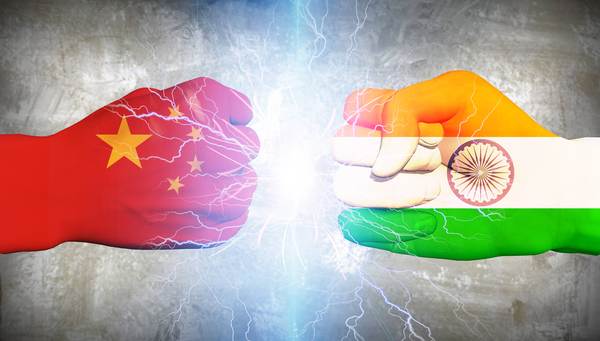China and India Make Waves in the Indian Ocean
By Dr. Jason J. Blazevic / Feb 1, 2017 / Columnist at Utah Standard News
The Indian Ocean has become the focus of increasing distrust between China and India. Both states have made comparison to the United States (US) Monroe Doctrine – India in reference to the ocean and China in reference to the South China Sea of which the strategic Strait of Malacca sits between. Both also share a similar focus on bilateral and multilateral arrangements toward the opposite region – characterized as the look east and look west policies by India and China respectively.[1]
Authorities of both states believe the attainment of geopolitical interests in the ocean would significantly enhance economic and thereby, national security. Indeed, the ocean is a locus of resources as well as sea lanes[2] which transit 70 percent of the world’s oil products and half of the world’s containers. The trade of both states is reliant on the ability of over 100,000 ships to transit through the Indian Ocean and the Strait of Malacca. The ocean also accounts for 40 percent of the world’s offshore oil production.[3]
China’s strategies[4] emphasize a modern long range capable navy and beneficial relations with littoral states. The navy plans for 351 ships[5] by 2020 with vessels such as, Houbei patrol vessels, Type 056 corvettes, Type 052 guided missile destroyers, Type 093 Shang class submarines, and the refurbished aircraft carrier Liaoning possibly followed by five more carriers.[6] Beginning in 2012, China’s navy began training and deploying[7] maritime intelligence collection vessels in the ocean. The navy also alleviated its weak distance and logistical capabilities through friendly ports and offshore bases. Such ports and bases were attained through political and commercial relations. For example, relations were benefited by port leasing and construction in the littoral states, Myanmar, Sri Lanka, and Pakistan.[8]
India’s strategies emphasize a much larger naval presence and beneficial relations with littoral states. In 2008, the Indian navy announced plans for a fleet of 160 ships by 2022.[9] The fleet will include 60 major combatant ships, 400 aircraft, and nuclear submarines divided amongst three separate fleets – each with its own modern aircraft carrier. The fleets will be stationed in the Arabian Sea, the Indian Ocean and the Bay of Bengal. In addition to naval expansion, India is building commercial and political relations with littoral states such as, Mauritius, Madagascar and Qatar and has also constructed ports as well as listening stations and airfields.[10]
China and India believe the Indian Ocean is essential to economic and thereby, national security. Both states perceive the other as threatening through supposed aggressive and expansionist policies. Such perceptions have led to further economic, political and military strategies to secure resources and the sea lanes. Authorities of both states believe the other may become a hostile power and will eventually seek outright hegemony in the ocean. However, engaged strategies can inadvertently be a significant driving factor of fear and further power acquirement strategies possibly leading to destructive conflict.
[1] Kaplan, Robert (2014) China’s Unfolding Indian Ocean Strategy – Analysis (Washington D.C.: Center for a New American Security). https://www.cnas.org/press/in-the-news/chinas-unfolding-indian-ocean-strategy-analysis
[2] Geraghty, Colin (2012) India in the Indian Ocean Region Re-calibrating U.S. Expectations (Washington D.C.: American Security Project). https://americansecurityproject.org/ASP%20Reports/Ref%200091%20-%20India%20in%20the%20Indian%20Ocean%20Region.pdf
[3] Australia Department of Defense (2016) Defense White Paper (Sydney: Department of Defense). Page 61-62. http://www.defence.gov.au/whitepaper/Docs/2016-Defence-White-Paper.pdf
[4] Kaplan, Robert (2014) China’s Unfolding Indian Ocean Strategy – Analysis (Washington D.C.: Center for a New American Security). https://www.cnas.org/press/in-the-news/chinas-unfolding-indian-ocean-strategy-analysis
[5] Kris Osborn. “Why the US Navy Could be in Big Trouble: China Plans 351 Ships by 2020.” The National Interest. May 9, 2016. http://nationalinterest.org/blog/the-buzz/why-the-us-navy-could-be-big-trouble-china-plans-351-ships-16101
[6] “MSDF spots China’s first aircraft carrier sailing into the Pacific.” Japan Times. December 25, 2016. http://www.japantimes.co.jp/news/2016/12/25/national/japan-spots-chinese-aircraft-carrier-east-china-sea-apparently-heading-pacific-first-time/#.WGGNz1MrKpo
[7] United States-China Economic and Security Review Commission (2014) China’s Navy Extends its Combat Reach to the Indian Ocean (Washington D.C.: U.S.-China Economic and Security Review Commission, Staff Report). http://www.uscc.gov/Research/china%E2%80%99s-navy-extends-its-combat-reach-
[8] Shannon Tiezzi. “Chinese Company Wins Contract for Deep Sea Port in Myanmar.” The Diplomat. January 1, 2016. http://thediplomat.com/2016/01/chinese-company-wins-contract-for-deep-sea-port-in-myanmar/
[9] Indian Navy Modernization. Global Security. http://www.globalsecurity.org/military/world/india/in-navy-development.htm
[10] Overseas Military Bases of a Budding Superpower. Defense News. http://www.defencenews.in/article/Overseas-Military-Bases-of-a-budding-Super-Power—India-119322
Biography: Dr. Jason J. Blazevic instructs courses in the Department of History and Political Science at Dixie State University, Saint George, Utah. He specializes in international relations, particularly international relations theory, East Asian and southeast Asian relations, and sea lane security.
Utah Standard News depends on the support of readers like you.
Good Journalism requires time, expertise, passion and money. We know you appreciate the coverage here. Please help us to continue as an alternative news website by becoming a subscriber or making a donation. To learn more about our subscription options or make a donation, click here.
To Advertise on UtahStandardNews.com, please contact us at: ed@utahstandardnews.com.



Comments - No Responses to “China and India Make Waves in the Indian Ocean”
Sure is empty down here...